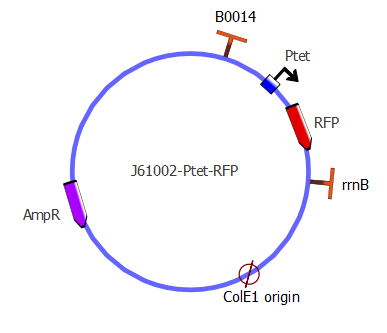Team:EPF-Lausanne/Our Project/Assembly
From 2011.igem.org
(→Backbone Template Assembly) |
(→Reporter Plasmid) |
||
| Line 10: | Line 10: | ||
== Reporter Plasmid == | == Reporter Plasmid == | ||
| - | The reporter plasmid contains the mutated TetR operator coupled to a LacI inverter, so that in presence of TetR the reporter gene is ''activated''. Two reporter plasmids are built: one that contains and RFP reporter, and one that contains a Lysis gene, to lyse the cells that contain valid | + | The reporter plasmid contains the mutated TetR operator coupled to a LacI inverter, so that in presence of TetR the reporter gene is ''activated''. Two reporter plasmids are built: one that contains and RFP reporter, and one that contains a Lysis gene, to lyse the cells that contain valid combinations of TetR and pTet mutants, in order to recover their DNA. Their structure is illustrated below. |
[[File:EPFL-Reporter_plasmids_both.png|700px|center]] | [[File:EPFL-Reporter_plasmids_both.png|700px|center]] | ||
Revision as of 09:27, 29 July 2011
Assembly Sequence
TODO: describe here the sequence of assembly for our plasmids: what plasmids we build; where the parts came from; what had to be done. For example, why did we have to rebuild J61002 from scratch?
This page will probably become very technical, in which case we will move it and replace by a succinct outline. The goal of this page is to keep everybody on the assembly team up to date on the ugly details of everybody's work. Leave nothing out!
Contents |
Reporter Plasmid
The reporter plasmid contains the mutated TetR operator coupled to a LacI inverter, so that in presence of TetR the reporter gene is activated. Two reporter plasmids are built: one that contains and RFP reporter, and one that contains a Lysis gene, to lyse the cells that contain valid combinations of TetR and pTet mutants, in order to recover their DNA. Their structure is illustrated below.
Backbone template assembly
The first step of assembly was to make a J61002 backbone, containing pTet and RFP. We had to make it, because it is not included in the gene delivery ( vincent, please confirm this!). This was our first successful Gibson assembly.
Vincent, please document this step. What template did you use, what primers, etc? Please include links to the sequences of the template, of the expected product, and if possible a table that summarizes that all, like Nadine did.
The product of this assembly is the J61002-pTet-RFP 'backbone' plasmid. It contains an ampicillin resistance gene, as well as RFP repressed by pTet. This plasmid is used as a template for the second step of assembly, in which the LacI inverter and reporter genes are introduced. The RFP is actually not directly. Copying it separately allows us to use the same primers and PCR products for the assembly of both reporter plasmids.
Adding the inverter and reporter
The second step is to add the LacI inverter and reporter gene into the backbone. Let's run through the elements one by one. We need:
- The backbone, which already contains the pTet promoter
- the LacI coding region, repressed by the pTet promoter
- a pLac promoter...
- ...that represses expression of a reporter gene either RFP or the Lysis cassette.
TODO: - illustrate which parts are copied from where.
- lookup biobrick numbers.
The backbone is copied from the previously-assembled J61002-pTet-RFP. The RFP gene is not included in this copy; this allows the same PCR primers and products to be used for the assembly of both plasmids. The LacI coding region is copied from the Repressilator plasmid. In the case of the RFP plasmid, RFP is copied from the J61002-pTet-RFP plasmid, making a fragment separate from the backbone. In the case of the Lysis plasmid, the lysis device is copied from the T4 Lysis device plasmid, from the iGEM gene distribution. In both cases, the pLac promoter is introduced by the primer, using an overhang.
Coding plasmid
 "
"

